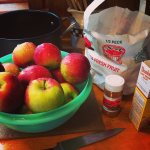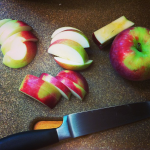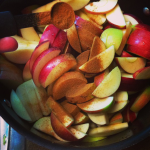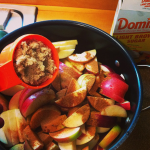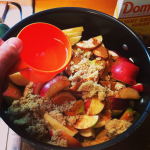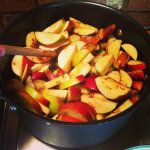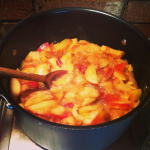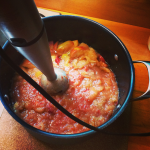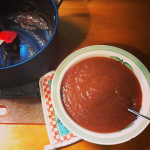This Meatless Monday, we feature apples, with growing, storage and prep tips, as well as recipes for Homemade Applesauce and Easier-Than-Pie Apple Crisp from Vermont Fresh: A Fruit and Vegetable Handbook. And if you want to pick your own apples, be sure to visit the orchards participating in our Pick for Your Neighbor program. At these orchards, you can pick a peck for yourself and for your neighbor!

Add 3/4 cup of brown or white sugar (you can always add more after cooking if needed). Photo courtesy of Shannon Palmer.
Background
The possible varieties of apples are unlimited. Each seed contains unique genes from its parent, so the fruit of each tree grown from seed will be unique. Today’s cultivated apple trees are not grown from seed, however, but from grafts of tried-and-true varieties. Wild apples probably originated in present-day Kazakhstan, but apples are now grown in almost every area of the world. In Vermont’s early days nearly every farm had a small apple orchard, but the fruit was often unpleasant and was turned into cider or brandy. Nowadays, apple varieties are cultivated to suit many purposes, from fresh eating to cooking to long-term storage. Apples are popular worldwide for their durability, portability, and capacity to grow in many different climates.
Growing Tips
If you do not yet have apple trees, visit a local nursery and ask for an easy-to-grow, cold-hardy variety. Ask for directions on how to train and prune the branches, too. If you have old trees that need some new life, they may need some heavy pruning (best done in late winter). Apple trees are very prone to pests, from fruit-eating moths to deer, which can demolish young trees. Because apple trees require care over many years, there are many growing tips. For more information, check out The Apple Grower by Michael Phillips.
Storage
Apples that ripen later in the season, especially tart ones with thicker skins, tend to store much better than those that ripen early. Always choose firm apples without bruises, as one rotten apple can spoil the rest. The best way to store apples is loosely wrapped in a plastic bag in the crisper drawer of your fridge. If space is tight, you can try wrapping them individually in newspaper and putting them somewhere cool, like a cellar. Be careful not to let the apples freeze, however, or they will spoil.
Nutritional Benefits
Containing only 100 calories on average and packed with fiber, apples make a superbly healthy snack. Fiber works hard for your body—not only does it keep cholesterol from building up in your blood vessels, but it also helps keep your intestines clear, meaning that it aids in the digestion of the food you eat. Apples are a good source of vitamins A and C as well as potassium and folate. To top it all off, apples are sodium- and fat-free!
Preparation
Before eating, rinse apples in warm water to remove the wax with which they’re sometimes coated for storage. Eating the skin is good for you! Peeling apples can remove up to half of the Vitamin C in the fruit. Apples are versatile: they are tasty raw, cooked, dried, processed into sauce, apple butter, or cider, and integrated into a variety of sweet and savory recipes.
Meatless Monday Recipe: Homemade Applesauce
Shannon Palmer, a volunteer baking, tasting and testing recipes out of the Vermont Fresh Handbook tried out this recipe. Her comments and adjustments are in italics.
prep time: 10 mins | cooking time (see below)
serves 8-12 (note: a 1/2 peck bag usually contains 12-15 apples)
Ingredients
- 8-10 large apples of a cooking variety (almost anything except Red Delicious. I find Macintosh or Empire are my favorites for their juicyness), peeled, cored, and cut into chunks. (or, you can leave the skins on, just make sure to wash first)
- ½ cup water
- 1 teaspoon cinnamon
- ¾ cup sugar or packed brown sugar
Crockpot Instructions (6-8 hours on low)
- Combine all ingredients in a crockpot, cover, and cook on low heat 6-8 hours.
- Puree in blender for smoother sauce (with caution if the sauce is still warm).
Stovetop Instructions (about 25 mins)
- Put apples, water, and cinnamon in large, heavy-bottomed pot. Cover and cook over low heat until apples are soft (20-25 minutes, depending on variety). Stir occasionally.
- Stir in sugar, increase heat, and stir regularly, cooking the sauce until it thickens.
- If desired, puree in blender for smoother sauce. (I like to use an immersion blender)
- 8-10 large apples of a cooking variety (almost anything except Red Delicious… Macintosh or Empire are favorites for their juicyness)… a 1/2 Peck bag of Macintosh apples is typically 12-15 medium to small apples and will easily feed 15-20 people. Photo courtesy of Shannon Palmer.
- Core and slice apples. You can leave the skins on for extra nutrition (and ease of preparation!), just make sure to wash them first, or you can peel the skins for an extra smooth sauce. Photo courtesy of Shannon Palmer.
- Add 1 teaspoon of cinnamon (you can always add more after cooking if needed). Photo courtesy of Shannon Palmer.
- Add 3/4 cup of brown or white sugar (you can always add more after cooking if needed). Photo courtesy of Shannon Palmer.
- Add 1/2 cup of water. Photo courtesy of Shannon Palmer.
- Stir together and then cook over low heat in a covered pot. (by adding the sugar and cinnamon before cooking like this you get the benefit of yummy apple pie-like aromatherapy). Photo courtesy of Shannon Palmer.
- Cook for 25-30 minutes stirring 2 -3 more times, until the apples are nice and mushy. Photo courtesy of Shannon Palmer.
- When you leave the skins on it’s best to use a blender to get your sauce smooth. I prefer the hand-held immersion blender (less to clean, and more control over blending). Just aim for the biggest chunks and blend until it’s the smoothness you’re looking for (about 3 mins). You can also add a dash more of cinnamon or sugar to taste at this point and blend that right in, but be sure you wait until it’s cool! Applesauce right off the stove is super hot! (I learned the hard way). Photo courtesy of Shannon Palmer.
Voila! Smooth yummy applesauce!
You can also try some variations like squeezing a lemon in (for a little extra tartness tweak), or, try throwing in 5 cleaned and cut strawberries (will make your sauce redder) or blueberries (will make your sauce darker) just before blending and then see if your family can guess the ‘secret ingredient’.
Another fun twist is try a variation of different kinds of apples together. If you throw a single Granny Smith in with a bunch of Macs you get a bit of tartness… by throwing a Pink Lady or two in with some Empires and using white sugar instead of brown sugar, your sauce will be a bit more pink than brown.
Meatless Monday Recipe: Easier-Than-Pie Apple Crisp
Serves 6
Ingredients
- 7 or 8 apples (preferably tart and crisp)
- 1 ½ teaspoon ground cinnamon
- 1 cup flour
- ⅔ cup rolled oats
- ¾ cup packed brown sugar
- ¼ cup chopped nuts (optional)
- ½ cup (1 stick) butter or margarine
Instructions
- Preheat oven to 375° F and grease a 2-quart baking dish.
- Core and cut apples into ½ inch-thick slices. Put slices in large bowl, then sprinkle on ½ teaspoon cinnamon, ⅓ cup flour, and ¼ cup brown sugar. Mix with a wooden spoon, then heap into baking dish.
- Cut butter into pieces. Combine remaining ingredients in small bowl and incorporate butter with a pastry blender or your fingers. Scatter over top of apples.
- Bake about 45 minutes or until top is golden brown and apples are bubbling. Cover with foil if necessary. Serve warm.
To receive more recipes and tips on your favorite fruits and vegetables, download Vermont Fresh: A Fruit and Vegetable Handbook. Vermont Foodbank fresh food initiatives would not be possible without your support. Please consider giving to the Vermont Foodbank today!

